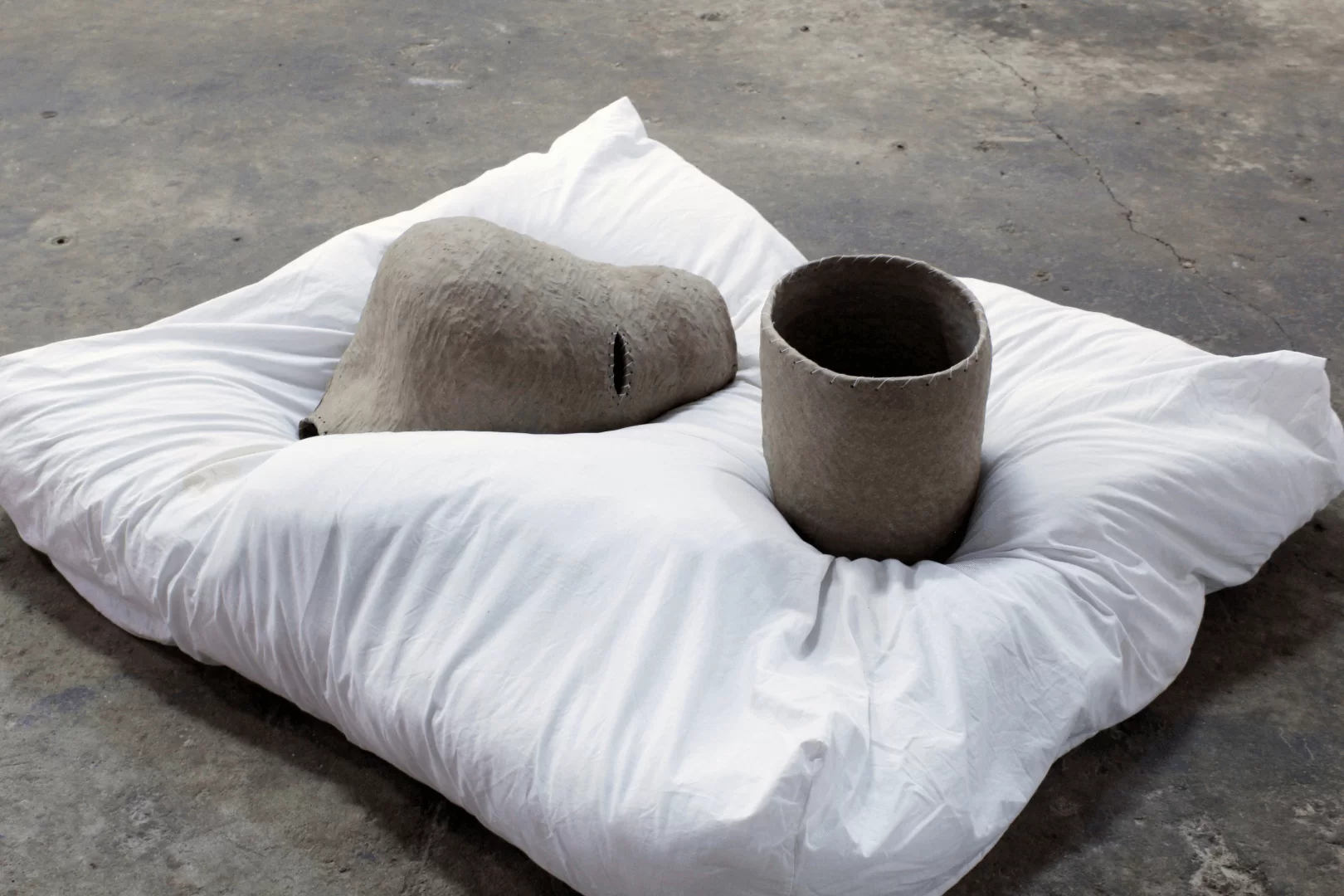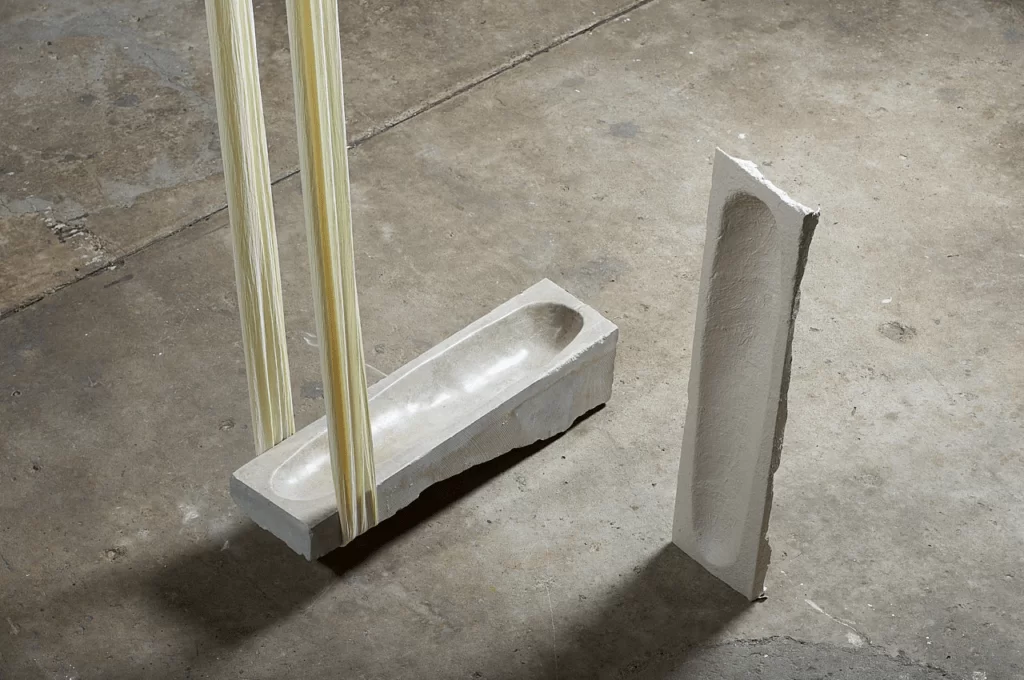Sofia Bicego is an artist who explores subjects of physical and emotional labour and trauma through sculpture, installation and drawing. She graduated from the College for Creative Studies with a bachelor’s degree in Fine Arts and a minor in Ceramics. For Bicego, art is also a vessel for personal investigation and healing as she sorts through her trauma, grief, and emotions.
In Bicego’s current work, “The More I Look, The More I Find”, a collection of sculptures, installations and drawings investigate the dichotomies of weight and weightlessness, moulding emotion and memory into a material vocabulary. These contrasting heavy and light entities act as healing objects, giving space for rest and repair after the complex process of grief or loss.
Art is an outlet and a way for me to sort through my trauma, grief and emotions. It’s a healing way for me to connect to my body and mind
Sofia Bicego
These works are also part of a collaborative thesis between Bicego and fellow CCS artist student Maya Davis. Although the two artists explore similar territory, their practices couldn’t be more different. This thesis perfectly demonstrates how two artists can come together and create something exceptional.
I caught up with Sofia and Maya to speak with them about their experiences studying at CCS and working together on their thesis. You can read Maya’s interview by clicking here.
Q: Hi Sofia, can you please introduce yourself for those who do not know?
Hi! My name is Sofia Bicego. I’m an artist primarily working in sculpture, installation, and drawing. I recently graduated from the College for Creative Studies with a bachelor’s degree in Fine Arts and a minor in Ceramics.

gauze, stoneware, alabaster, bedsheet.
Q: Can you tell us how you started in arts, how art has played a role in your lives, and why you decided to become an artist?
A: I think I’ve always been drawn to creative outlets, whether it be art or writing. My paternal grandmother loved art, and I have many fond memories of creating with her in the craft room in her home. My mother’s side of the family is full of artists and writers, so I think I was destined to become an artist!
Though I’ve always been creative, I didn’t regularly make art until middle school. I developed generalized anxiety disorder and suffered from debilitating panic attacks regularly. After making my family Christmas ornaments one year, I realized art was a useful and healthy coping mechanism to process all of the big feelings I had. After that, my mom and I cleared out space in my basement so I could have a studio. A few years later, my high school art teachers were extremely supportive and encouraged me to dual enrol at CCS and work towards making my artistic practice a career.
Even now, as I’m emerging as a professional artist, I’m using art in a similar way as I did when I was twelve. Art is an outlet and a way for me to sort through my trauma, grief and emotions. It’s a healing way for me to connect to my body and mind and for those to connect to the world around me.
Q: As artists, both of your practices involve examining themes of physical and emotional labour and trauma and its impact on the physical body while using contrasting methods and media. Can you tell us more about your practice, inspiration and creative process?
A: Definitely! I truly admire Maya as a person and an artist. Talking and creating with them has been really fulfilling. I think the themes in our work are often similar. My practice evolved from painting imagery of death’s physicality to exploring grief and trauma as it relates to my body through sculpture. My earlier vessels and urn pieces were turning points for my practice as I began to think about spaces of holding within the body.
Those pieces helped me understand myself as a person and artist in a way I hadn’t before. The current work tends to directly reflect the emotional labour and care I offer myself as I process my trauma and grief from growing up with an abusive parent and experiencing significant losses. For me, healing from trauma is physical as much as psychological. So, in recent years I’ve leaned on artistic processes that are physically all-encompassing, like carving, ceramics, and installation.
Q: The College for Creative Studies (CCS) provides students with the tools needed for
successful careers in the dynamic and growing creative industries. Can you tell us more about the programme, what the experience was like and how it has contributed to your practice?
A: I chose to go to CCS for Fine Arts because their program wasn’t concentration-oriented. I didn’t have exposure to anything but drawing and painting in high school, and I wanted to try out everything I could get my hands on at CCS. I spent my first few semesters taking a mix of painting, sculpture, and printmaking classes to figure out what I liked best.
I appreciated CCS’s interdisciplinary approach to art. Another plus is that class sizes are small, so I got comfortable with my peers and professors. The most valuable part of my academic experience was the different people I met that became my mentors and close friends. Because the department is small, I was able to evolve in my practice with guidance from mentors that knew me and my work well. And through other classes, I was also receiving critiques from people who were new to my work. There was a good mix of subjectivity and objectivity in critique.
Q: The studio is the sacred temple of creativity. What are three things you can’t live without in your studio?
A: Honestly, I’m still trying to figure out my studio space since I’ve only been out of the institution for a few months! But if I were to pick. The first thing would be my hammock. It’s a must for breaks and ideation. I love the feeling of being suspended and completely enveloped by something, and it gives me a lot of ideas for new hollow and hanging forms.
The second would be my earbuds. I tend to focus more while listening to music or podcasts, and that background noise helps me absorb into what I’m making. Plus, it’s fun to create playlists for different processes! The third thing is my notebook. Random words and forms often pop into my head, and I always keep a notebook near me to record them.
Q: In your opinion, what’s more significant, the story behind the work or the quality of the work itself?
A: I hate to say both, but it truly is both for me. I think an idea or story is great, but the work overall isn’t successful if it isn’t executed well. In my practice, the process of making the work is as important as the final piece.
In order to tell the story adequately, I must find the material and process that make the most sense. For example, in my thesis work, I used the physical labour of carving as a metaphor for the emotional labour of healing. I tried to show that in the final pieces through nuances in composition and form.
Q: What’s next for you as an artist?
A: What’s next for me is a little unclear. There’s been so much uncertainty the past few years with the pandemic, and, like many, I feel like I’m still recovering from it all. I’m figuring out my practice outside of the institutional setting, but I’m still making work, and I’m open to whatever comes my way!
Q: Lastly, what does art mean to you?
A: For me, art is therapy and community and friendship. Art has gotten me through many difficult things, and I’ve made many friendships through it. “What does art mean to you?” is such a big question that I’m not entirely sure I can fully answer. Art feels like an essential part of me as a person. I don’t feel whole without it. I get depressed when I’m not creating. Art feels like a deep connection within myself and the rest of the world.
https://www.instagram.com/sofiaelizabethbicego/
©2022 Sofia Bicego







